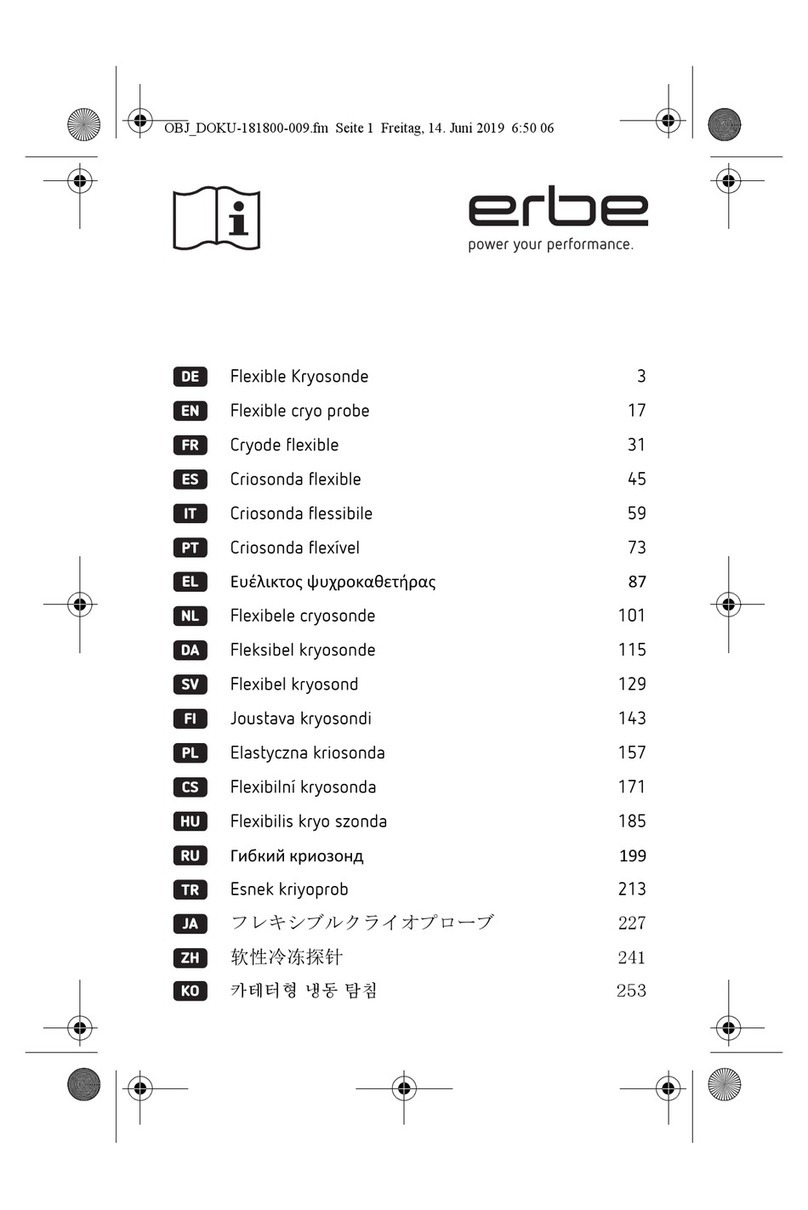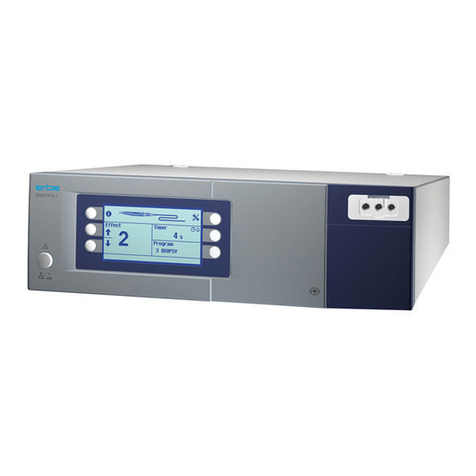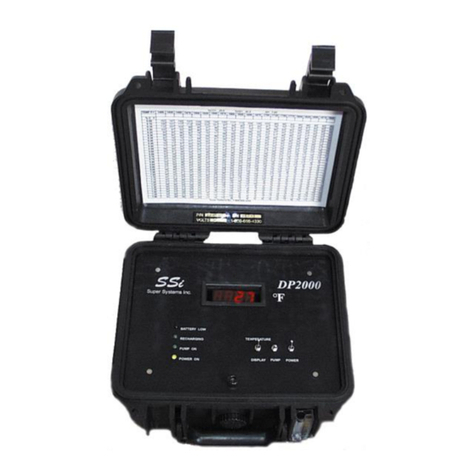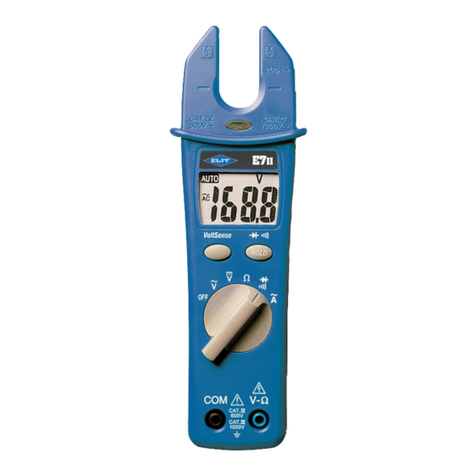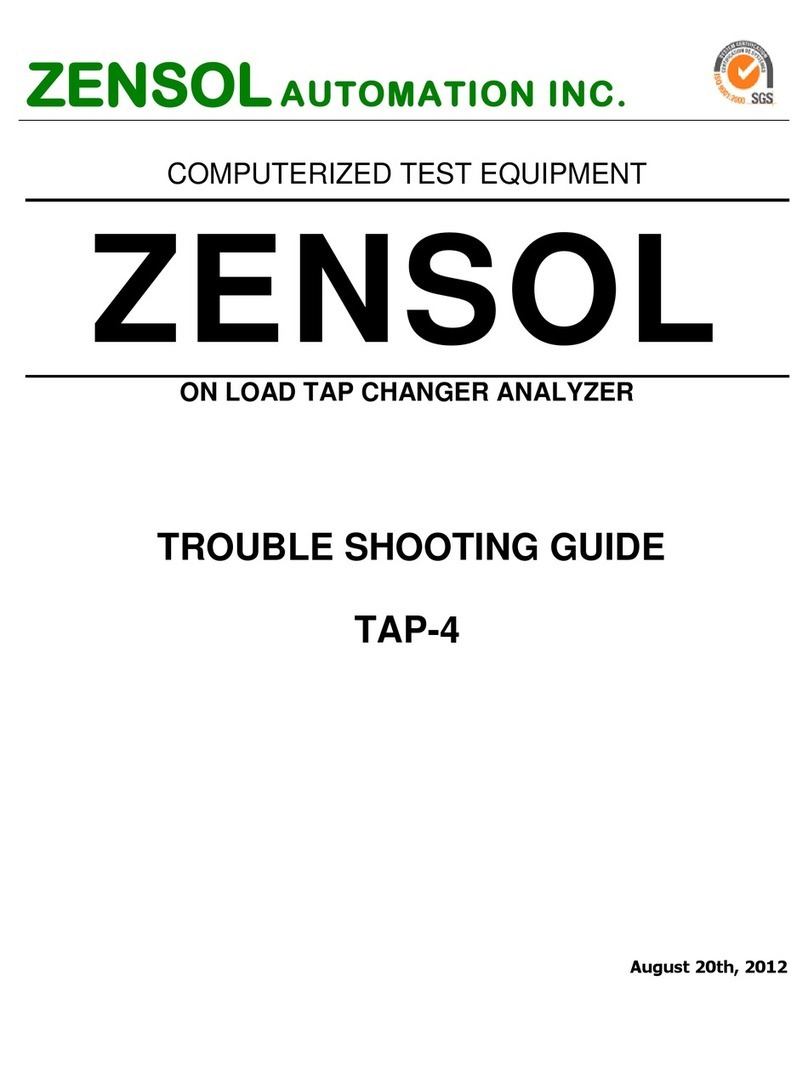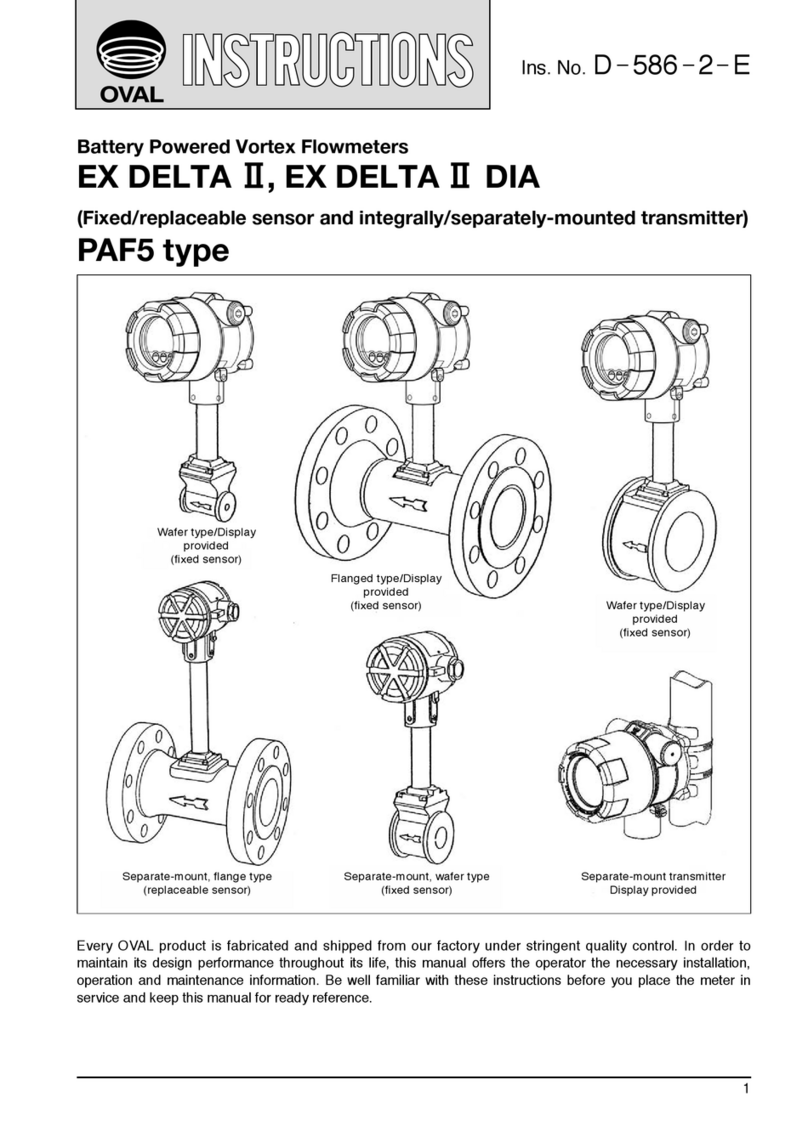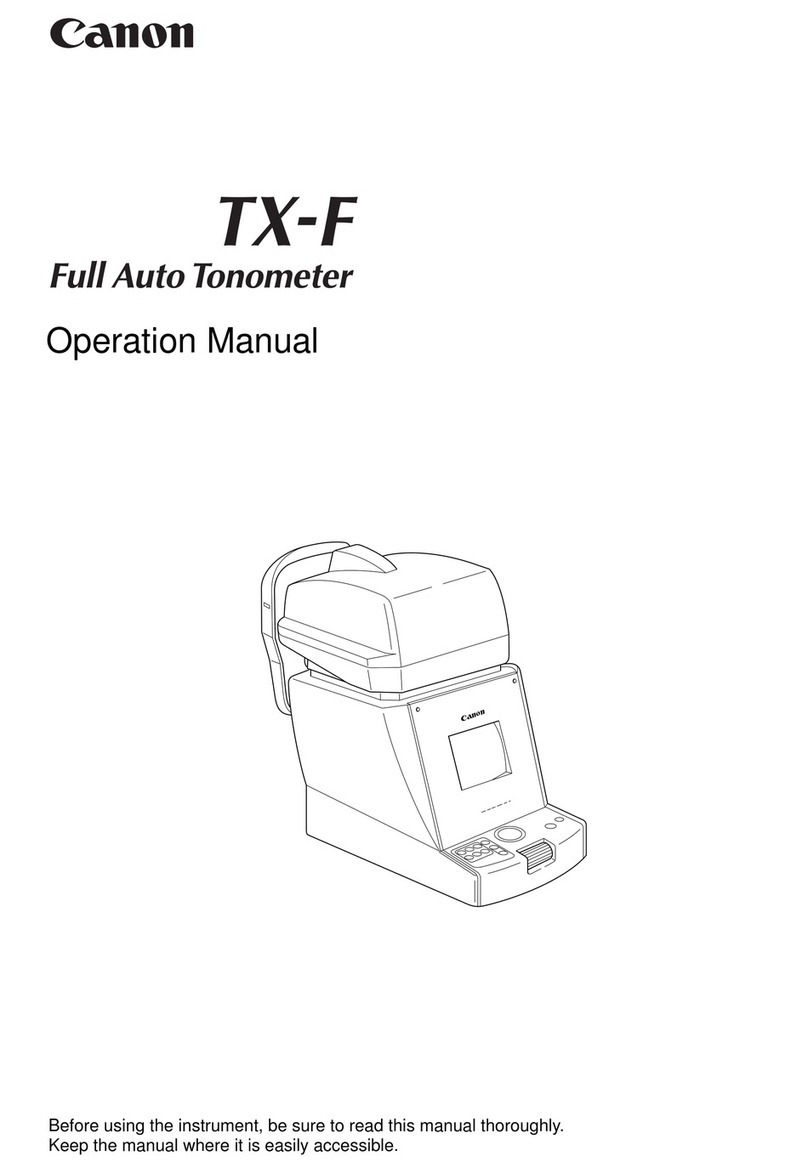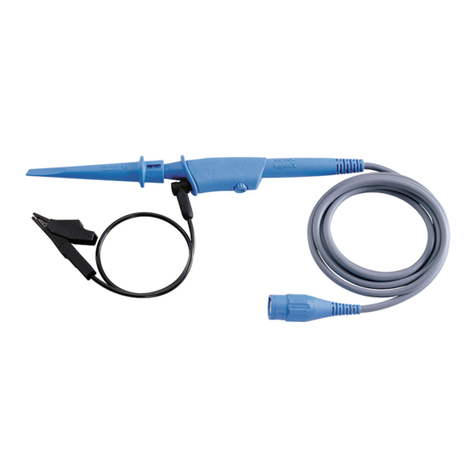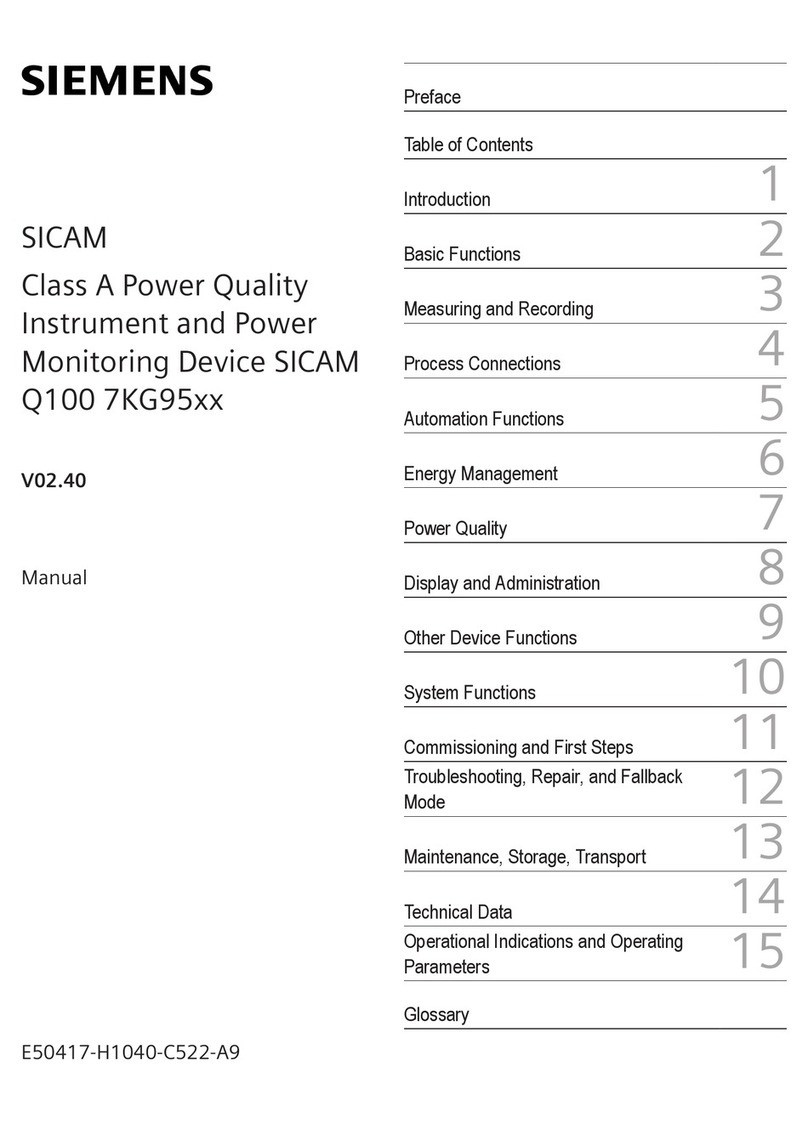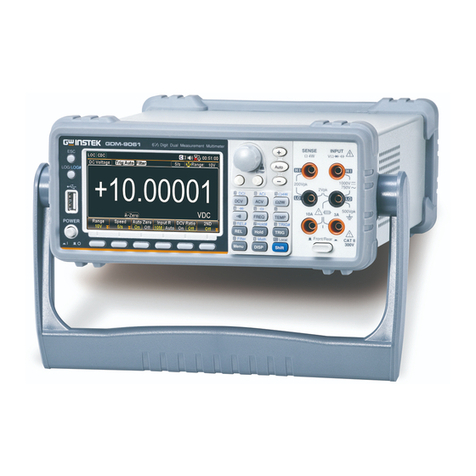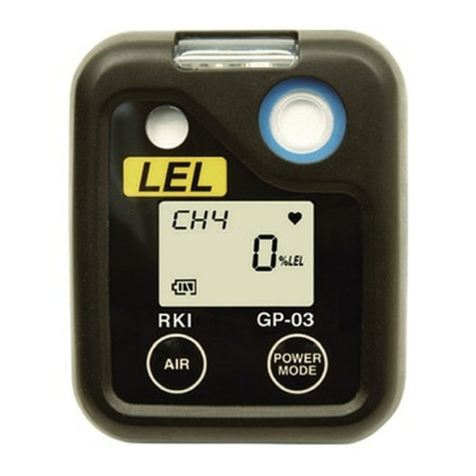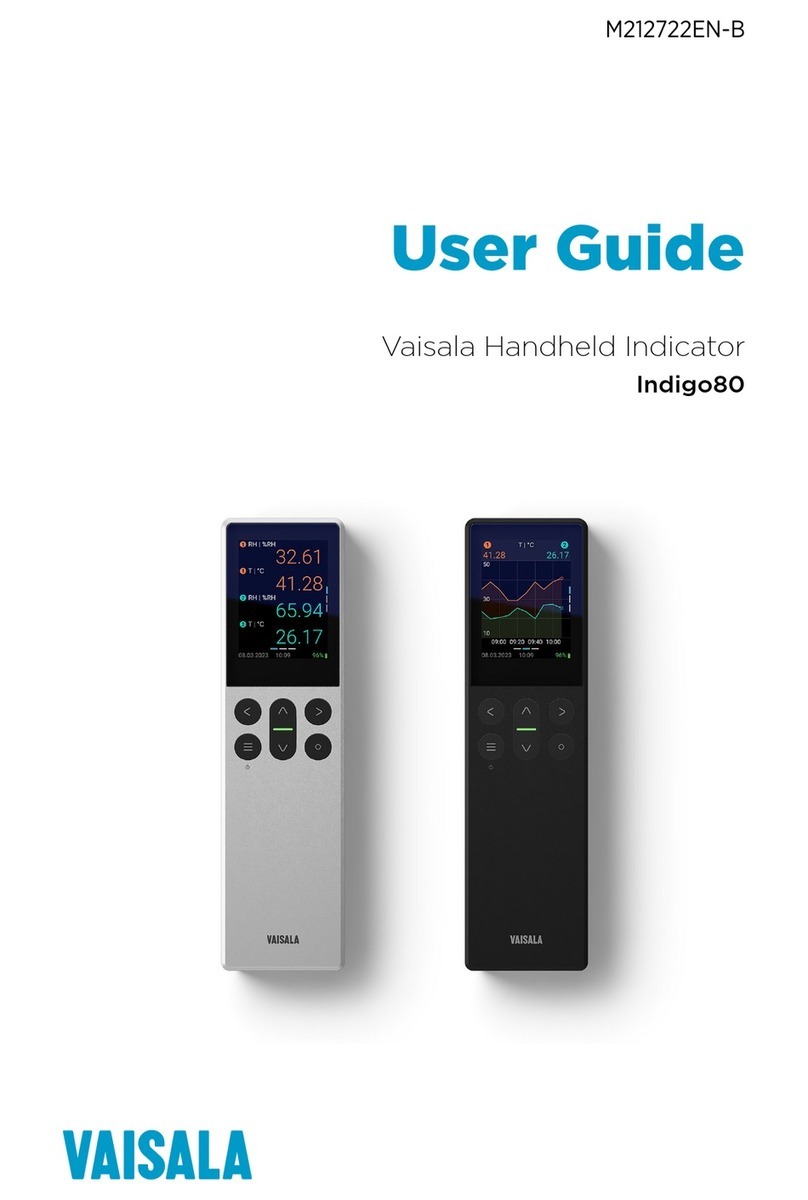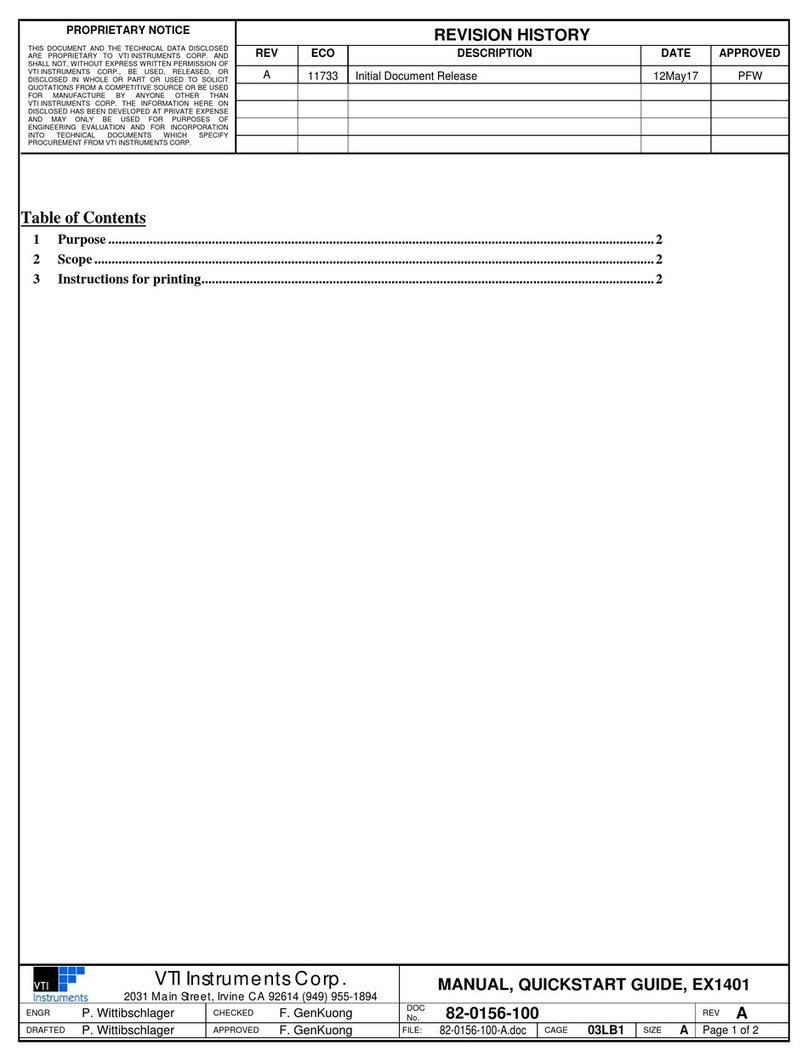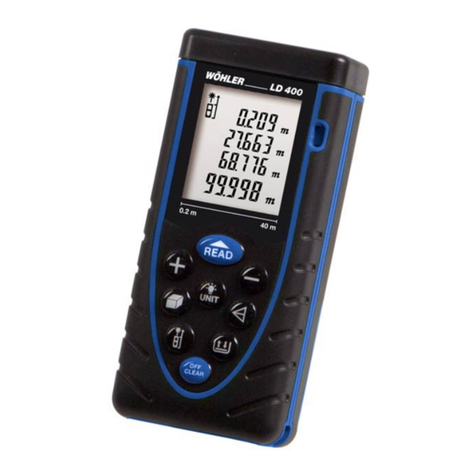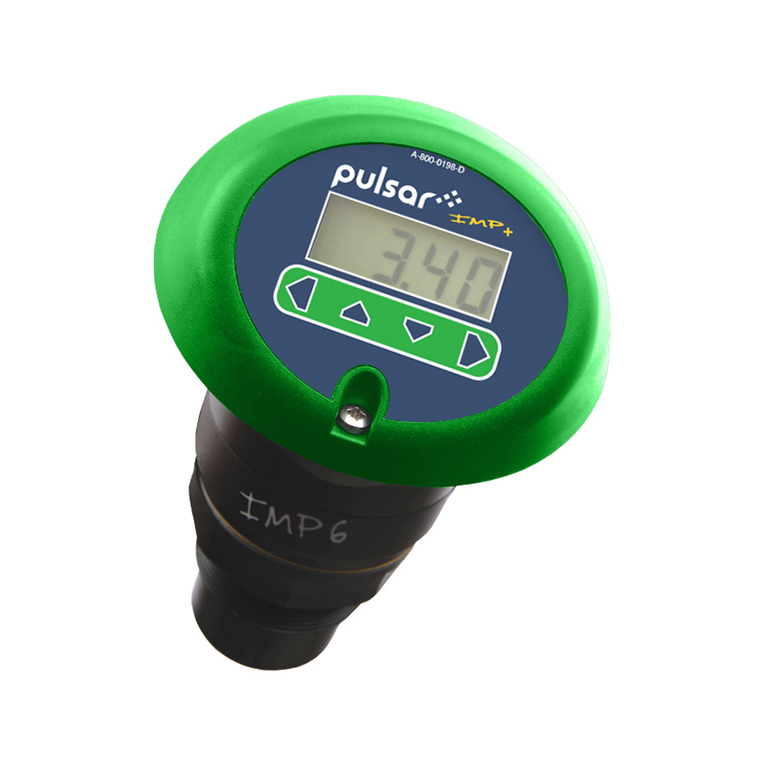Erbe APC 300 Operating instructions

APC 300-Druckminderer, Argongasflasche 3
APC 300 pressure reducer, argon gas cylinder 13
APC 300 pressure reducer 23
APC 300 Détendeur, bouteille de gaz argon 33
APC 300 Reductor de presión , cilindro de argón 43
APC 300-Riduttore di pressione, bombola di argon 53
APC 300 Redutor de pressão, garrafa de gás árgon 63
Περιοριστής πίεσης APC 300, φιάλη αερίου αργού 73
APC 300-drukregelaar, argongasfles 83
APC 300-trykreduktionsanordning, argongasflaske 93
APC 300-tryckreduceringsventil, argongastub 103
APC 300-paineenalennin, argonpullo 113
Reduktor ciśnienia APC 300, butla z argonem 123
Reduktor tlaku APC 300, argonová lahev 133
APC 300-Nyomásreduktor, argongázpalack 143
APC 300-Редуктор давления, аргоновый баллон 153
APC 300-Basınç azaltıcı, argon gaz tüpü 163
APC 300- 减压器,氩气瓶 173
DE
EN
USA
FR
ES
IT
PT
EL
NL
DA
SV
FI
PL
CS
HU
RU
TR
ZH
OBJ_DOKU-194191-002.fm Seite 1 Donnerstag, 9. Juni 2016 11:08 11

OBJ_DOKU-194191-002.fm Seite 2 Donnerstag, 9. Juni 2016 11:08 11

DE
VERWENDUNGSHINWEIS
APC 300-Druckminderer,
Argongasflasche
20132-004, 20132-052, 20132-065, 20132-074, 20132-076
OBJ_DOKU-194191-002.fm Seite 3 Donnerstag, 9. Juni 2016 11:08 11

4
Inhalt
WICHTIG! . . . . . . . . . . . . . . . . . . . . . . . . . . . . . . . . . . . . . . . 7
1 Lagerung und Transport . . . . . . . . . . . . . . . . . . . . . . . . . . . 7
2 Bestimmungsgemäßer Gebrauch . . . . . . . . . . . . . . . . . . . . 7
3 Sicherheitshinweise. . . . . . . . . . . . . . . . . . . . . . . . . . . . . . . 8
3.1 Einsatz von Gasen und deren Behältern, die unter
hohem Druck stehen . . . . . . . . . . . . . . . . . . . . . . . . . . . 8
3.2 Einsatz von Argon . . . . . . . . . . . . . . . . . . . . . . . . . . . . . 9
3.3 Einsatz des Druckminderers . . . . . . . . . . . . . . . . . . . . . 9
4 Anwendungshinweise . . . . . . . . . . . . . . . . . . . . . . . . . . . . 10
4.1 Allgemeines . . . . . . . . . . . . . . . . . . . . . . . . . . . . . . . . . 10
4.2 Flaschenwechsel. . . . . . . . . . . . . . . . . . . . . . . . . . . . . . 10
5 Reinigung und Desinfektion . . . . . . . . . . . . . . . . . . . . . . . 11
OBJ_DOKU-194191-002.fm Seite 4 Donnerstag, 9. Juni 2016 11:08 11

5
Anschluss des Druckminderers an die Gasflasche
1. Gasflaschenventil
2. Überwurfmutter des Druckminderers
3. Manometer
13
2
OBJ_DOKU-194191-002.fm Seite 5 Donnerstag, 9. Juni 2016 11:08 11

6
Anschluss der Druckleitungen an das APC 300
1. Druckleitung
2. Ablassbolzen
1
2
OBJ_DOKU-194191-002.fm Seite 6 Donnerstag, 9. Juni 2016 11:08 11

7
WICHTIG!
Bitte lesen Sie alle Informationen sorgfältig!
Dieser Verwendungshinweis ersetzt nicht die Gebrauchsanwei-
sung des verwendeten APC-Geräts! Lesen Sie die Gebrauchsan-
weisung des APC-Geräts und fragen Sie in Zweifelsfällen Erbe
oder Ihren Vertreiber!
1Lagerung und Transport
Für den Transport sind die entsprechenden nationalen Verord-
nungen oder internationalen Vereinbarungen zu beachten. All-
gemein gilt:
•Gasflaschen dürfen nur mit Ventilschutz (z.B. Flaschenkap-
pe) transportiert werden.
•Flaschenventile müssen dicht verschlossen sein.
•Gasflaschen dürfen weder geworfen noch Stößen ausgesetzt
werden.
•Liegende Gasflaschen müssen so verkeilt oder festgebunden
werden, dass sie nicht rollen. Gasflaschen dürfen in geeigne-
ten Vorrichtungen (z.B. Paletten) auch stehend transportiert
werden. Gasflaschen müssen beim Transport so gesichert
sein, dass eine Beschädigung durch andere Güter ausge-
schlossen ist.
2Bestimmungsgemäßer Gebrauch
Die Argongasflasche ist ausschließlich zum Anschluss an ein
Erbe APC 300 bestimmt.
Der APC 300-Druckminderer ist ausschließlich zum Anschluss an
eine Argongasflasche bestimmt, die Argon für das Erbe APC 300
liefern soll.
Als Arbeitsgas kommt ausschließlich Argon (Ar) in Frage.
OBJ_DOKU-194191-002.fm Seite 7 Donnerstag, 9. Juni 2016 11:08 11

8
WARNUNG!
3Sicherheitshinweise
3.1 Einsatz von Gasen und deren Behältern, die unter
hohem Druck stehen
Transport-, Lagerungs- und andere Aktivitäten dürfen nur von
qualifiziertem Personal und mit dafür geeigneten Mitteln ausge-
führt werden!
Verwenden Sie kein Fett oder Schmiermittel.
Schützen Sie die Gasflasche vor Erwärmung durch Heizkörper
oder offene Flammen.
Auf Gasflasche, Flaschenanschlüsse, Druckminderer und Druck-
leitung darf keinerlei Gewalt ausgeübt werden. Kontrollieren Sie
die Dichtungen von Druckminderer und Druckleitung vor Anwen-
dung auf Beschädigung. Schadhafte Gasflaschen, Flaschenan-
schlüsse, Druckminderer und Druckleitungen nicht verwenden.
Informieren Sie umgehend den Gaslieferanten oder Erbe Elekt-
romedizin.
Schützen Sie die Gasflasche bei Transport, Lagerung und An-
wendung vor Umfallen oder Herabfallen durch Ketten, Bügel, Si-
cherheitsgurte. Benutzen Sie immer den Sicherheitsgurt des
fahrbaren Gerätewagens.
Vor Transport der Argongasflasche demontieren Sie bitte den
Druckminderer.
Argongasflaschen dürfen nur mit den von Erbe vorgesehenen
Druckminderer und Druckleitungen an das APC-Gerät ange-
schlossen werden!
Verwenden Sie nur Argongasflaschen, die den jeweiligen natio-
nalen Sicherheitsstandards entsprechen.
Beim Öffnen des Gasflaschenventils entsteht durch das in die
Schläuche strömende Argon ein kurzes Zisch-Geräusch. Hält
dieses Zischen nach Öffnen einer Argongasflasche länger als
OBJ_DOKU-194191-002.fm Seite 8 Donnerstag, 9. Juni 2016 11:08 11

9
2 Sekunden an, so liegt ein Leck vor. Schließen Sie das Gasfla-
schenventil sofort wieder. Das APC-Gerät darf erst dann verwen-
det werden, wenn das Leck behoben ist. Achten Sie darauf, dass
die Druckleitungen dicht am APC-Gerät angeschlossen sind.
Gleiches gilt für den Anschluss des Druckminderers an der Ar-
gongasflasche.
3.2 Einsatz von Argon
Argon ist schwerer als Luft. Durch Anreicherung in der Atemluft
kann – ohne direkte Anzeichen – Luftsauerstoff verdrängt wer-
den, so dass Erstickungsgefahr besteht. Symptome für Sauer-
stoffmangel sind Schläfrigkeit, Blutdruckanstieg und Atemnot. In
reiner Argon-Atmosphäre erfolgt ohne vorherige Anzeichen so-
fortige Bewusstlosigkeit und Erstickung!
Das APC-Gerät darf nur mit Argon betrieben werden. An die Fla-
schenanschlüsse des Gerätes können möglicherweise Gasfla-
schen mit gefährlichem Inhalt angeschlossen werden. Prüfen Sie
deshalb die Gasflaschen, ob sie auch Argon enthalten (d.h. pas-
sender Farbanstrich der Argongasflasche/des Flaschenmantels,
Aufkleber mit Produktbezeichnung). Kennzeichnungen dürfen
nicht beschädigt oder beseitigt sein.
3.3 Einsatz des Druckminderers
Verwenden Sie kein Fett oder Schmiermittel.
Hantieren Sie niemals an der Verschraubung des Druckminde-
rers, solange dieser unter Druck steht! Gas kann schlagartig ent-
weichen oder den Druckminderer explosionsartig wegschleu-
dern.
Beaufschlagen Sie den Druckminderer niemals in umgekehrter
Richtung (d.h. ausgangsseitig) mit Druck, weil das APC-Gerät
hierdurch verunreinigt und beschädigt werden kann.
OBJ_DOKU-194191-002.fm Seite 9 Donnerstag, 9. Juni 2016 11:08 11

10
4Anwendungshinweise
4.1 Allgemeines
Öffnen Sie das Gasflaschenventil immer langsam und behutsam.
Schließen Sie nach Ende jeder Anwendung das Gasflaschenventil.
Benutzen Sie zur Bedienung, Montage und Demontage des
Druckminderers keinerlei Werkzeuge.
Rauchen Sie nicht in der Nähe von Gasflaschen und Druckminde-
rern.
4.2 Flaschenwechsel
WICHTIG! Für den Flaschenwechsel muss das APC 300 einge-
schaltet sein.
Beachten Sie auch die Fotografien am Anfang dieser Anleitung.
1. Schließen Sie das Gasflaschenventil! Das Gasflaschenventil
kann unter Umständen etwas schwergängig sein.
2. Ziehen Sie die Druckleitung (Schnellkupplung) vom An-
schluss auf der Rückseite des APC-Gerätes.
3. In der Druckleitung befindet sich noch eine Restmenge Ar-
gon, das abgelassen werden muss. Setzen Sie dazu die
Schnellkupplung auf den Ablassbolzen an der Rückwand des
APC-Gerätes und drücken sie dagegen. Das restliche Argon
entweicht nun mit einem lauten Zischgeräusch (Kontrolle:
Das Hochdruckmanometer muss 0 anzeigen).
4. Gegen den Uhrzeigersinn: Drehen und ziehen Sie die Über-
wurfmutter des Druckminderers von Hand von der Argon-
gasflasche ab (kein Werkzeug verwenden).
5. Wechseln Sie die Argonflasche.
6. Im Uhrzeigersinn: Drehen Sie die Überwurfmutter des Druck-
minderers an der neuen Argonflasche von Hand fest (kein
Werkzeug verwenden). Achten Sie dabei auf einwandfreien
Zustand und Sitz des O-Rings in der Nut des Flaschenan-
schlusses.
OBJ_DOKU-194191-002.fm Seite 10 Donnerstag, 9. Juni 2016 11:08 11

11
WARNUNG! Überprüfen Sie den Druckminderer auf festen
Sitz an der Argonflasche. Der Druckminderer darf nicht wa-
ckeln.
7. Setzen Sie die Druckleitung (Schnellkupplung) auf den An-
schluss an der Rückseite des APC-Gerätes auf.
8. Öffen Sie langsam das Gasflaschenventil bis zum Anschlag.
Drehen sie es dann wieder ca. eine halbe Umdrehung zurück.
Das Argon strömt nun in die Leitungen (evtl. ist ein kurzes
Zischgeräusch zu hören)
WARNUNG! Hören Sie ein Zischen länger als 2 Sekunden
liegt ein Dichtigkeitsfehler vor. Schließen Sie das Gasfla-
schenventil sofort wieder. Kontrollieren Sie den Anschluss
von Druckminderer und Druckleitung, ist er wirklich dicht.
Das APC-Gerät darf erst eingesetzt werden, wenn der Dich-
tigkeitsfehler behoben ist.
5Reinigung und Desinfektion
Nicht sterilisieren!
Reinigen Sie den Druckminderer ausschließlich von außen. Ver-
wenden Sie dazu einen Baumwolllappen und medizinischen Al-
kohol. Jede andere Art der Reinigung ist untersagt!
WARNUNG! Brennbare und explosible Stoffe müssen vor dem
Einschalten des APC- und des HF-Chirurgiegerätes vollständig
verdunstet sein.
OBJ_DOKU-194191-002.fm Seite 11 Donnerstag, 9. Juni 2016 11:08 11

12
OBJ_DOKU-194191-002.fm Seite 12 Donnerstag, 9. Juni 2016 11:08 11

EN
NOTES ON USE
APC 300 pressure reducer, argon gas
cylinder
20132-004, 20132-052, 20132-065, 20132-074, 20132-076
OBJ_DOKU-194191-002.fm Seite 13 Donnerstag, 9. Juni 2016 11:08 11

14
Table of Contents
IMPORTANT! . . . . . . . . . . . . . . . . . . . . . . . . . . . . . . . . . . . 17
1 Storage and transport . . . . . . . . . . . . . . . . . . . . . . . . . . . . 17
2 Normal Use. . . . . . . . . . . . . . . . . . . . . . . . . . . . . . . . . . . . . 17
3 Safety instructions. . . . . . . . . . . . . . . . . . . . . . . . . . . . . . . 18
3.1 Using gases and their containers when under high
pressure . . . . . . . . . . . . . . . . . . . . . . . . . . . . . . . . . . . . 18
3.2 Using argon . . . . . . . . . . . . . . . . . . . . . . . . . . . . . . . . . 19
3.3 Using the pressure reducer . . . . . . . . . . . . . . . . . . . . . 19
4 How to use . . . . . . . . . . . . . . . . . . . . . . . . . . . . . . . . . . . . . 19
4.1 General . . . . . . . . . . . . . . . . . . . . . . . . . . . . . . . . . . . . . 19
4.2 Changing the cylinder . . . . . . . . . . . . . . . . . . . . . . . . . 20
5 Cleaning and disinfection . . . . . . . . . . . . . . . . . . . . . . . . . 21
OBJ_DOKU-194191-002.fm Seite 14 Donnerstag, 9. Juni 2016 11:08 11

15
Connecting the pressure reducer to the gas cylinder
1. Gas cylinder valve
2. Retainer nut of the pressure reducer
3. Manometer
13
2
OBJ_DOKU-194191-002.fm Seite 15 Donnerstag, 9. Juni 2016 11:08 11

16
Connecting the pressure lines to the APC 300
1. Pressure line
2. Purge post
1
2
OBJ_DOKU-194191-002.fm Seite 16 Donnerstag, 9. Juni 2016 11:08 11

17
IMPORTANT!
Please read all information carefully.
These instructions for use do not replace the user manual of the
APC unit used! Read the user manual of the APC unit and ask
Erbe or your distributor in case of doubt!
1Storage and transport
The corresponding national regulations or international agree-
ments must be observed with regard to transportation. Generally
the following is applicable:
•Gas cylinders may only be transported with a valve guard
(e.g. cylinder cap).
•Cylinder valves must be tightly sealed.
•Gas cylinders may not be thrown or exposed to impact.
•Gas cylinders placed in a horizontal position must be wedged
in or secured in such a way that they do not roll. Gas cylin-
ders may also be transported upright when appropriate
equipment (e.g. pallets) is used. Gas cylinders must be se-
cured during transport in such a way that damage as a result
of other items is excluded.
2Normal Use
The argon gas cylinder is intended exclusively for connection to
an Erbe APC 300 unit.
The APC 300 pressure reducer is intended exclusively for con-
nection to an argon gas cylinder aimed at supplying argon to the
Erbe APC 300.
Only argon (Ar) may be used as the working gas.
OBJ_DOKU-194191-002.fm Seite 17 Donnerstag, 9. Juni 2016 11:08 11

18
WARNING!
3Safety instructions
3.1 Using gases and their containers when under high
pressure
Transport, storage and other activities may only be carried out
by qualified personnel and using appropriate equipment!
Do not use oil or grease.
Protect the gas cylinder against heat generated by radiators or
exposed flames.
Do not apply force of any kind to gas cylinders, cylinder connec-
tors, pressure reducers or the pressure line. Check the seals of
the pressure reducer and the pressure line for damage prior to
use. Do not use damaged gas cylinders, cylinder connectors,
pressure reducers or pressure lines. Inform your gas supplier or
ERBE Elektromedizin without delay.
When transporting, storing, or using the gas cylinder, prevent it
from falling over or dropping by securing it with chains, hoops,
or safety straps. Always use the safety strap of the mobile equip-
ment cart.
Detach the pressure reducer prior to transporting the argon gas
cylinder.
Argon gas cylinders may only be connected to the APC device us-
ing the pressure reducer and pressure lines specified by Erbe!
Only use argon gas cylinders that correspond to the respective
national safety standards.
When opening the gas cylinder valve, there will be a brief hissing
sound as a result of the argon flowing into the tubes. If the hiss-
ing sound continues for more than 2 seconds after an argon gas
cylinder has been opened, there is a leak. Close the gas cylinder
valve again immediately. The APC device may only be used when
the leak has been rectified. Make sure that the pressure lines are
OBJ_DOKU-194191-002.fm Seite 18 Donnerstag, 9. Juni 2016 11:08 11

19
tightly connected to the APC device. The same applies when con-
necting the pressure reducer to the argon gas cylinder.
3.2 Using argon
Argon is heavier than air. If it accumulates in the air that is
breathed in, oxygen may be displaced – without any obvious in-
dication – resulting in a risk of suffocation. Symptoms of oxygen
deficiency include drowsiness, rise in blood pressure, and respi-
ratory distress. In an atmosphere of pure argon, a person would
fall unconscious immediately without prior warning and suffo-
cate!
The APC device may only be operated with argon. It is possible
to connect gas cylinders with hazardous contents to the cylinder
connectors of the device. For this reason, you must verify wheth-
er the gas cylinders do indeed contain argon (i.e. appropriate
color code on the argon gas cylinder / cylinder jacket, label with
product name). Labels must not be damaged or removed.
3.3 Using the pressure reducer
Do not use oil or grease.
Never fiddle with the screw of the pressure reducer as long as
the regulator is under pressure! Gas can escape abruptly or
cause the pressure reducer to be ejected in explosive fashion.
Never apply pressure to the pressure reducer in the reverse di-
rection (i.e. on the output side), as this can contaminate and
damage the APC device.
4How to use
4.1 General
Always open the gas cylinder valve slowly and carefully.
Always close the gas cylinder valve after use.
OBJ_DOKU-194191-002.fm Seite 19 Donnerstag, 9. Juni 2016 11:08 11

20
Do not use any kind of tool to operate, attach or detach the pres-
sure reducer.
Do not smoke in the vicinity of gas cylinders and pressure reduc-
ers.
4.2 Changing the cylinder
IMPORTANT! The APC 300 must be switched on in order to
change the bottle.
Also observe the illustrations at the start of these instructions.
1. Close the gas cylinder valve! The gas cylinder valve may be
a little difficult to turn in some cases.
2. Remove the pressure line (quick coupling) from the connec-
tion on the rear of the APC device.
3. The pressure line still contains a residual amount of argon
that must be discharged. To do so, place the quick coupling
onto the purge post on the rear of the APC device and press
against it. The residual argon is now discharged with a loud
hissing sound (check: 0 must be shown on the high pressure
manometer).
4. In the counter-clockwise direction: turn and remove the re-
tainer nut of the pressure reducer by hand from the argon
gas cylinder (do not use any tools).
5. Change the argon gas cylinder.
6. In the clockwise direction: screw the retainer nut of the pres-
sure reducer by hand on the argon gas cylinder and secure
tightly (do not use any tools). Ensure that the O-ring is in ap-
propriate working order and is correctly positioned in the
groove of the cylinder connector.
WARNING! Check that the pressure reducer is securely posi-
tioned on the argon gas cylinder. The pressure reducer
should not be loose.
7. Place the pressure line (quick coupling) onto the connection
on the rear of the APC device.
OBJ_DOKU-194191-002.fm Seite 20 Donnerstag, 9. Juni 2016 11:08 11
Other manuals for APC 300
1
Table of contents
Languages:
Other Erbe Measuring Instrument manuals
